
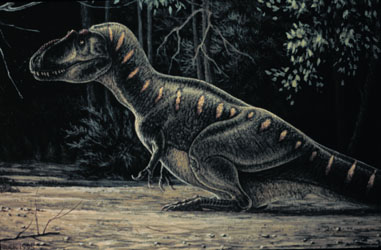
The late Campanian North American Daspletosaurus torosus at rest. © 1997, Michael Skrepnick.
The following represent the synapomorphies supporting the phylogeny presented in the Tyrannosauridae page, and are based on analyses of Holtz (in press a, b).
The monophyly of Aublysodontinae is only weakly supported by two premaxillary tooth characters:
- Premaxillary tooth serrations absent
- Strongly developed vertical ridge on caudal surface of premaxillary teeth
Note that the first of these may be a preservational artifact. Aublysodontine form teeth are reported in the skulls of Alectrosaurus olseni, Aublysodon molnari, and an unnamed new taxon from the Kirtland Shale of northwestern New Mexico (Lehman and Carpenter 1990). While the latter taxon is comparable in size to the larger tyrannosaurines, the former two are considerably smaller. As aublysodontines are at present only known from fragmentary specimens, and are otherwise characterized by plesiomorphic features transformed in Tyrannosaurinae, future analyses may show that some taxa currently in Aublysodontinae are more closely related to the tyrannosaurines.

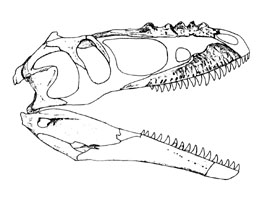
The skull of the primitive early Maastrichtian Mongolian tyrannosaurid Alioramus remotus. © 1995, Tracy Lee Ford.
Tyrannosaurinae is diagnosed by the following features:
- Nasals rugose
- Frontals with caudal end expanded laterally
- Supratemporal fossa occupies laterocaudal half of frontal
Tyrannosaurinae as used here comprises the taxon Alioramus remotus (which shares several derived braincase characters with Albertosaurus, Tarbosaurus, and Tyrannosaurus), Albertosaurus sarcophagus, Gorgosaurus libratus, Daspletosaurus torosus, an unnamed taxon from the upper Two Medicine Formation, Tarbosaurus bataar, and Tyrannosaurus rex.
Tyrannosaurines other than Alioramus share the following derived characters:
- Maxillary tooth count 13 or fewer
- Postorbital dorsal surface with enlarged bump in adults
- Supraoccipital excluded from foramen magnum margin
- Vertical depth of caudal portion of dentary twice or more as deep as depth at symphysis
- Dentary tooth count 15 or fewer
- Lateral teeth incrassate (cross-section greater than 60% as wide mediolaterally as long craniocaudally)
Additionally, the following features are currently known only for these advanced tyrannosaurines, but may be more widely distributed. However, incompleteness of currently known specimens of Aublysodontinae and Alioramus prevents confirmation of the exact distribution of these characters:
- Premaxillary tooth row arcade more mediolaterally than rostrocaudally oriented
- Lateral nuchal crest formed by parietals present, at least twice as tall as foramen magnum vertical height
- Pair of tab-like processes on supraoccipital wedge
- Basisphenoidal sphenoidal sinus deep, with large foramina
- Prominent muscular fossae on dorsal surface of palatine absent
- Rostral portion of fused vomers expanded to greater than twice shaft width
- Supradentary fused to coronoid, restricting lateral motion of intramandibular joint (Hurum and Currie 2000)
- Distal caudal neural spines axially elongate
- Acromial expansion well-developed, more than twice scapula midshaft width
- Scapula contributes more than half of the glenoid
- Scapular-humerus ratio between 2.2 and 2.5
- Metacarpal III very reduced and bears no digit
- Ilium long, slight shorter than femur
- Horizontal medial shelf from preacetabular blade to sacral ribs
- Broad ventral hook-like projection from preacetabular blade of ilium
- Pronounced midline crest on ilium
- Supracetabular crest on ilium reduced
- Pubic boot enlarged, approximately one-half pubis (or femur) length
- Ischium shaft long but more slender and shorter than pubis
The poorly-known Shanshanosaurus houyanshanensis shares with the advanced tyrannosaurines a reduced maxillary and dentary tooth count. Additional features demonstrate the tyrannosaurid nature of this taxon (Holtz in press a, b), but its precise position among the tyrant dinosaur cannot be established pending more detailed study of the specimen.

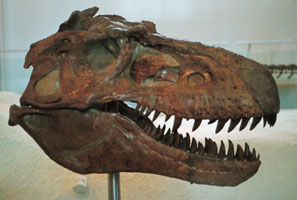
The skull of the late Campanian North American tyrannosaurine Gorgosaurus libratus. © 2000, Thomas R. Holtz, Jr.
Although many authors (Russell 1970, Paul 1988, Carpenter 1992) have united Albertosaurus sarcophagus and Gorgosaurus libratus in the same genus (Albertosaurus by principle of priority), most of the characters used to justify this union represent plesiomorphies lacking in the more derived tyrannosaurines. As in Holtz (in press a, b) the original generic names are retained. Two potential synapomorphies joining Albertosaurus and Gorgosaurus are:
- Lacrimal horn rostral to descending ramus of lacrimal
- Ventral pocket to ectopterygoid chamber greatly reduced
However, in trees equally parsimonious to those uniting Albertosaurus and Gorgosaurus, other characters justify union of Gorgosaurus and the Daspletosaurus-Tarbosaurus-Tyrannosaurus clade to the exclusion of Albertosaurus.
A clade of robust tyrannosaurines is supported by the following derived features:
- Ilium longer than femur
- Pubic boot approximately two thirds or more pubis (or femur) length
- Size of maxillary fenestra expanded to approximately two-thirds the diameter of the eyeball-bearing portion of the orbit
- Nasals pinched between lacrimals, thinnest point 1/2 mediolateral with of the thickest portion or less
- Margin of external antorbital fenestra on craniolateral surface of descending ramus of lacrimal flattens out and is not continued on surface of jugal
- Ectopterygoid sinus inflated
- Surangular surface slightly pendant, overhangs dorsal margin of caudal surangular foramen
- Cervical centra less than one half as long as height of vertical face, so that neck is much shorter than dorsal series
- Tallest cervical neural spines taller than vertical diameter of centrum
This clade contains Daspletosaurus, an unnamed form from the Two Medicine Formation (briefly described in Horner et al. 1992), Tarbosaurus, and Tyrannosaurus. The Two Medicine tyrannosaurine shares some derived features with Daspletosaurus, and others with Tarbosaurus and/or Tyrannosaurus, so that its phylogenetic position is currently unresolved (Holtz in press b).
The skulls of the giant Maastrichtian species Tarbosaurus bataar of Mongolia (left) and Tyrannosaurus rex of North America (right).
Tarbosaurus photo © 1996, Thomas R. Holtz, Jr.; Tyrannosaurus photo © 1993, Michael K. Brett-Surman.
Tyrannosaurus and Tarbosaurus are united by several synapomorphies:
- Lateral flange of maxilla obscuring cranialmost portion of maxillary fenestra terminates along cranial margin of antorbital fossa
- Curvature of ventral margin of maxilla even more pronounced than in other tyrannosaurids
- Dorsal surface of antorbital fossa contacts the nasal margin
- Dorsal ramus of lacrimal with inflated appearance
- Descending and dorsal rami of lacrimal meet at strongly acute angle
- Rugose postorbital boss
- Suborbital prong of postorbital
- Frontal main body rectangular, only small triangular cranial prong remains
- Supratemporal fossa occupies most of dorsal surface of frontal, fossae meet along midline to form frontal sagittal crest
- Nuchal crest mediolateral width more than twice height
- Palatine trapezoidal
- Two or more foramina on dorsal surface of palatine
- Metacarpal II 170% length of metacarpal I or shorter
- Distal end of manual unguals blunt
Some authors (Paul 1988, Carpenter 1992, Holtz 1994, in press a, in press b) retain the use of the original name Tyrannosaurus bataar for the large Nemegt Formation tyrannosaurine. Following Carr (1999) and Holtz (in press a, b) the taxa Maleevosaurus novojilovi, Gorgosaurus lancinator, and Tarbosaurus efremovi are regarded as different early ontogenetic stages of Tarbosaurus bataar, and Nanotyrannus lancensis and Albertosaurus megagracilis as a juvenile and subadult specimen of Tyrannosaurus rex, respectively.

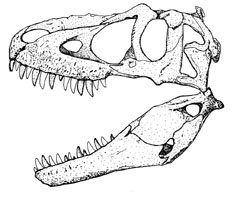
The skull of the late Campanian North American tyrannosaurine Daspletosaurus torosus. © 1995, Tracy Lee Ford.
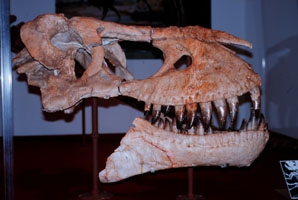
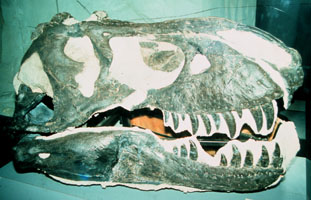



 Go to quick links
Go to quick search
Go to navigation for this section of the ToL site
Go to detailed links for the ToL site
Go to quick links
Go to quick search
Go to navigation for this section of the ToL site
Go to detailed links for the ToL site